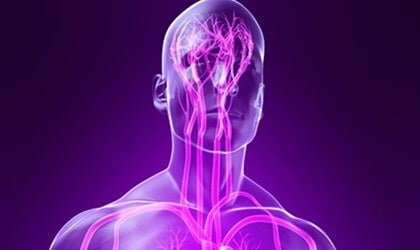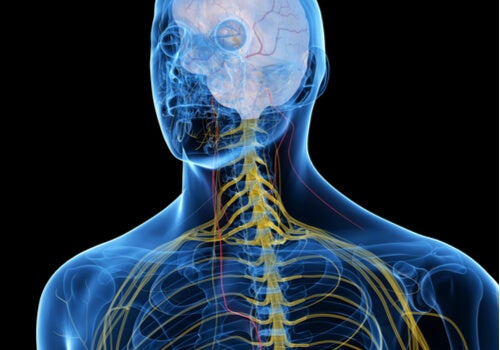The Somatic Nervous System: Characteristics and Functions

The essential function of the nervous system is communication. Experts divide the nervous system into the somatic nervous system (SNS) and the autonomic nervous system (ANS).
The somatic nervous system is also a complex system. It’s the part of the nervous system that’s involved in carrying sensory information to the central nervous system. In other words, the somatic nervous system is in charge of the communication between the body and the outer environment. On the other hand, the ANS is in charge of the communication between organs. This is the mechanism by which the body maintains homeostasis.
The SNS also acts through the skeletal muscles. It regulates voluntary and reflex actions. Through its receptors, this system perceives the changes that are produced. That’s why motor fibers located in the somatic nervous system have some characteristics that are different from those of the autonomic nervous system:
- First of all, the system has no ganglia.
- The neural segments are located within the central nervous system. Furthermore, they carry their information in an uninterrupted way until they reach the effector (skeletal muscle).
- Also, their relay speed is much faster.
The SNS can stimulate or not stimulate the effector, but it also doesn’t inhibit it.

Sensory pathways of the somatic nervous system (SNS)
In order for you to be able to perceive a sensation, the information also has to reach the cerebral cortex. So the pathway is the way that information goes through a group of neurons that link the peripheral nervous system to the central nervous system.
In order for a sensory stimulus to arrive at its destination, which is the central nervous system, it must go from the receptors to the central nervous system. It does this through a connection with three neurons. In the somatosensory cortex, there’s also a proportional representation to the sensitivity of the different parts of the body (1). In this representation, not all of the areas are of the same size. Areas such as the fingertips and the lips take up the most space in this representation.
There are various types of sensory pathways. According to the modality of the senses that they drive, experts divide them into the following groups:
- The fine touch pathway – Discriminative or epicritic sensitivity.
- Pathway for crude touch – Crude or protopathic sensitivity.
- The pathway for pain and temperature.
- Proprioceptive pathway – Bodily position.

Neural pathways by stimulus
Another way of naming them is also according to the source of the stimulus:
- Exteroceptive pathways. Relay information coming from the skin.
- Interoceptive pathways. Relay information about internal organs.
- Proprioceptive pathways These paths relay information from the musculoskeletal system.
In order to transmit the sensation, the nervous impulses travel through three neural relays:
- First-order neurons. They send the information from the body’s periphery.
- Second-order neurons. Are located in the posterior horn of the spinal marrow or torso. They’re in charge of transmitting the nervous impulse from the torso to the thalamus. There’s where the synapse with the third-order neuron occurs.
- Third-order neurons. They’re thalamic relay neurons. Their function is to drive the nervous impulse toward the somatosensory areas of the region located behind the fissure of Ronaldo in the parietal lobe.
Before reaching the cortex, where the sensation is interpreted, the thalamus processes all sensory information (except for olfactory inputs). Afterwards, they’re integrated into the parietal cortex, where sensitivity is normally integrated.
Motor pathways
When you stretch out your hand to take something, this mental process requires the contraction and relaxation of muscles. In this case, it involves the muscles of the arm as well as the hand.
Motor pathways are also involved in these movements. They relay nervous impulses from the central nervous system all the way to the skeletal muscles (somatic effectors). The body uses motor neurons to carry this process out. These are located in the anterior horn of the spinal marrow.

Experts divide the motor tract system into three bundles depending on the origin and endpoint of the nerves:
- Corticogeniculate or corticonuclear. The destination of these are the motor neurons of the cranial nerves. In other words, this is also the pathway that controls facial muscles.
- Juxta-pyramidal. The nerves start in area four of the frontal convolution. Their destination is the bulbar reticular formulation.
- The pyramidal or corticospinal tract. Links the cortex with the neurons of the anterior horn to the spinal marrow. Through this link, it controls the muscles of the torso, neck, and extremities.
Therefore, the somatic nervous system is also a complex system. In order to produce movement from the central nervous system, it has to make various connections. The same also happens when someone touches you or you brush against an object, as a multitude of neurons and areas need to work together.
All cited sources were thoroughly reviewed by our team to ensure their quality, reliability, currency, and validity. The bibliography of this article was considered reliable and of academic or scientific accuracy.
-
Leira, M. S. (2012). Generalidades del sistema nervioso somático y de las vías de conducción. Manual de bases biológicas del comportamiento humano.
-
Tassinary, L. G., Cacioppo, J. T., & Vanman, E. J. (2017). The somatic system.
- Boggia, J. (2007), Fisiopatología, Compendio Udelar, Facultad de Medicina, Oficina del libro.
This text is provided for informational purposes only and does not replace consultation with a professional. If in doubt, consult your specialist.








